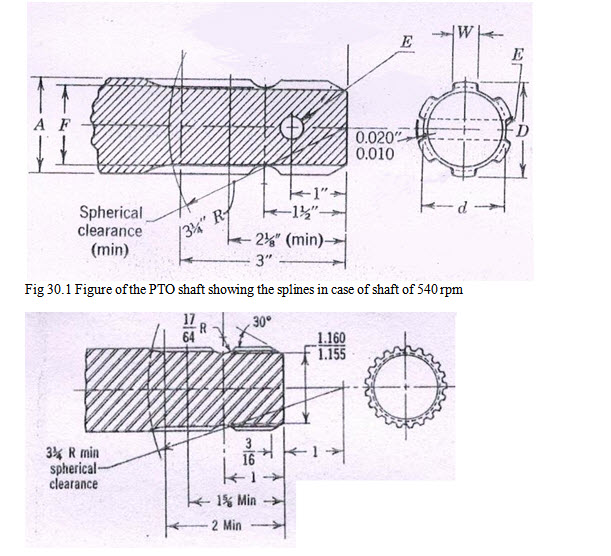Site pages
Current course
Participants
General
Module 1. Tractor Mechanics
Module 2. Traction
Module 3. Introduction to Transmission System
Module 4. Clutch System
Module 5. Gear Box
Module 6. Differential and Final drive
Module 7. Brakes
Module 8. Steering system
Module 9. Hydraulics
Module 10. Power Transmission
Module 11. Human Factors
Lesson 30. Tractor power outlets-study of P.T.O. and standards
A tractor is used for not only pulling the implements for tillage operations, sowing of various crops, etc., but also used to power stationary equipment for doing operations such as threshing of crops, pumping water from tube-wells, etc. A power outlet is generally provided at the rear of the tractors. The power outlet is known as Power Take Off (PTO). The PTO has been provided on tractors for quite some time. In India the PTO is usually on the rear side, but in developed countries, a front PTO is also provided for driving front mounted machines.
Power to the PTO shaft comes from the gear box. The counter shaft of the gear box is usually extended out to the rear side to act as the PTO outlet.
Standardization of the speed of the PTO is important so that the equipment can be designed around the given speed. For example, the threshers are supposed to run at a particular peripheral velocity of the threshing cylinder. The pulley arrangements are made with the standard PTO speed in mind.
Prior to 1958, the standard PTO speed was 536 rpm. Later this speed was changed to 540 rpm and another speed was added to the standards i.e. 1000 rpm. The splines provided over the PTO out shaft are also different for avoiding accidental attachment of implement of different speed setting. Fig 30.1 shows the cut section of the PTO out shaft alongwith the shape and type of splines on the shaft for a setting of 540 rpm.
Fig. 30.2 shows the cut section of the PTO out shaft alongwith the shape and type of splines for a setting of 1000 rpm. In case of 540 rpm, the shaft has 6 splines, while for the 1000 rpm shaft, the number of splines are 21.
Setting of speed
This setting of the rpm speed is generally for ¾ setting of the hand accelerator of the tractor. For a tractor engine having a peak torque at a given rpm of the engine, usually called the rated speed of the engine. The rated speed of the engine at which it develops the best torque is generally got at the said ¾ setting of the accelerator. This is highlighted in the below example.
For example a diesel engine of a, say, 35 hp tractor, develops around 150 Nm @ nearly 1700 rpm of the engine. The maximum rpm of the engine usually settle at 2200 rpm. The best torque is usually at when the accelerator is pulled down to ¾ setting. This 1700 rpm is input to the gear box. The speed reduction at the primary to counter shaft is such that for this rated engine speed, the counter shaft rotates at 540 rpm. This rpm is then extended out at the rear side and is the PTO.
